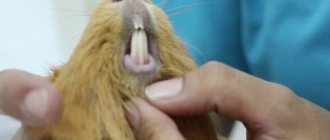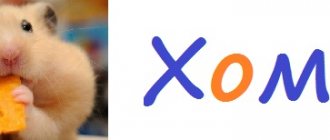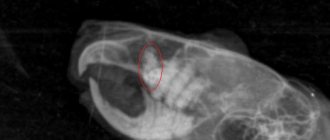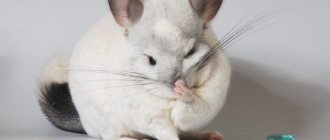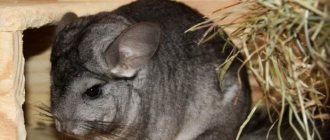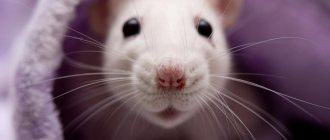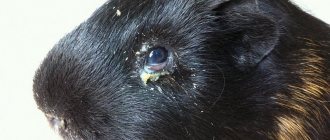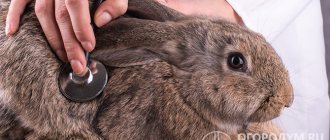Like many other rodents, all types of chinchillas have teeth that grow continuously throughout the pet's life. In the wild, this does not bother them in any way, since animals wear out their teeth by chewing hard food, tree bark, etc. But if a chinchilla is kept at home, it is important to provide the animal with suitable conditions, otherwise the chinchilla’s teeth will grow for a long time and cause serious health problems in the pet. pet. If they are already grown, you may need to take your chinchilla to the vet to have them trimmed. The doctor must be properly licensed to provide veterinary services for exotic animals.
chinchilla teeth
Number of teeth and their structure
How to look at a chinchilla's teeth if this is your first pet of this species? The first time it’s quite difficult, because visually you can only see the pet’s front teeth, and only if you move the upper lip? Experienced breeders know how many teeth a chinchilla has – there are 20 of them:
- at the top and bottom there are 2 incisors - 4 in total (depending on the size of the individual - from 6 to 12 mm long);
- The 16 other teeth are 4 premolars on both gums, two each, and 12 molars on the sides of them.
The chewing teeth of this rodent have a ribbed and wide surface. They are located deep in the gums - the total length of the tooth reaches 12 mm (9 mm - root, 3 mm - crown). These animals have no fangs - the space between the incisors and molars is called “diastema”.
Inexperienced owners often wonder why chinchillas have yellow teeth? This is fine. The front row of a healthy adult chinchilla is always dark yellow or even orange. The fact is that the back of a chinchilla’s teeth is not covered with enamel, so they quickly wear off and become stained the color of the food they eat, for example, carrots. But the cubs are initially born with white incisors.
Newborn babies have 4 incisors and only 8 molars.
Teeth trimming
Chinchilla owners can learn how to trim their pet's teeth, but it is advisable to have a veterinarian or an experienced chinchilla breeder show you how to do this first. 's teeth are vital, and improper trimming can be both painful and harmful. When it comes to trimming molars, the safest route is to let an experienced veterinarian do it.
Teeth trimming
Trimming the incisors
The incisors can be trimmed using a dog trimmer. The tip of the tooth is cut off in the same way as if you were cutting the tip of a dog's claw. This is a high-risk method because there is a serious risk of accidentally cracking or splitting the tooth.
A more popular method is to use a hand-held rotary tool, such as a Dremel, where a cutting wheel is used to cut off the tip of the tooth. Care must be taken not to touch the gums or lips. Veterinarians often suggest performing this procedure under anesthesia to make it less stressful for the animal.
Molar trimming
Diagnosing molars as overgrown and trimming them is a task that is best left to an experienced veterinarian. Anesthesia is used and the animal temporarily falls asleep. A dental bur and hand instruments are used to carefully secure the molars.
Causes of dental diseases
The first indicator that a pet has dental problems is refusal to eat. The reason may be that the fangs have grown too long, and the animal is simply uncomfortable eating. This immediately affects the pet’s weight. Owners should know how to grind a chinchilla's teeth - the animal should be comfortable eating at home. Trimming the fangs at home is not recommended; you should take the animal to the veterinarian.
In artificially bred chinchillas, dental disease factors can be:
- anomalies due to artificial breeding;
- lack of solid food (do not forget - the pet is a rodent);
- injuries to the jaws, due to which the teeth are displaced;
- diseases of internal organs due to artificial selection, which affects the quality of bone tissue;
- lack of calcium (minerals) in food.
If a female has produced offspring with such abnormalities, professional breeders do not allow these individuals to reproduce.
Dental problems
Chinchillas sometimes have dental problems, the reasons are due to:
- Bad genetics
- Unbalanced diet
- Injuries to the jaw or teeth
Animals that have genetic defects in their teeth do not always cause problems for their owner. Very often, chinchillas with white teeth live without problems and live the same long lives as their brothers. But there are also cases when a chinchilla is very much more than that and you have to very often monitor it and the condition of its teeth. In this case, you will have to spend a lot of time and sometimes money to ensure that your pet grows up healthy. Therefore, it is better to make sure that the animal is completely healthy before purchasing.
HOWEVER, such individuals do not participate in mating, so that bad genes are not passed on to the next generation. They are usually recommended to be kept alone in a cage.
From poor nutrition , even healthy individuals will have dental problems.
In order for teeth to grow correctly, it is necessary that the chinchilla’s diet include:
- Hard grains for chinchillas to chew
- All essential microelements, especially calcium
- Twigs or pieces of wood for something to chew on
If the diet is correct, then the chinchilla will grind down its teeth while eating and will not need any additional care or treatment. Make sure that your chinchilla always has something to chew in his cage and that there is enough calcium in his food.
A fairly rare occurrence, but sometimes chinchillas get injured from falls and bruises. Most often this happens to owners who let their chinchillas roam unattended.
After receiving an injury, the jaw may shift or the bite may be disrupted and the incisors will begin to grow incorrectly, because the chinchilla will not be able to grind them down. In this case, there should be no home treatment; immediately take it to the veterinarian so that he can correct everything and prescribe treatment.
In rare cases, the incisors may break, but here everything can be solved by simply grinding them down, then the incisors will grow back on their own and there will be no more problems.
Types of dental diseases in chinchillas
The chinchilla's jaw is designed in such a way that at the initial stage, dental problems can go unnoticed. Pathology appears already when the disease is advanced. And this is dangerous, since the animal begins to experience dysfunction of the digestive tract and liver.
For example, if a chinchilla has lost a lower tooth, and the owner did not notice it in time, then he can determine the problem by the wet fur around the mouth and on the chin. In this situation, you should immediately contact a veterinarian and determine why this is happening? This should not be the case for animals; they are adapted to eat carefully by nature itself.
Dental pathologies in chinchillas are different.
Dental pathologies
It is very important to monitor the health of the animal’s oral cavity, in particular its teeth. Otherwise, this may lead to the development of various diseases that have negative consequences and can be life-threatening for the rodent. Ignoring dental pathologies in a chinchilla can even provoke the death of the animal.
With improper or inadequate nutrition, as well as for a number of other reasons, various dental pathologies can occur. Dental diseases can have an extremely negative impact on the general condition of the rodent - they may refuse to eat and, because of this, lose weight. If the disease is ignored, the animal may die, so it is advisable to contact a veterinarian if problems arise.
A fairly common problem is the need to trim teeth; it is not recommended to carry out this procedure at home; it is better to do it in a hospital setting.
The doctor carries out this manipulation using painkillers; teeth grinding does not take much time and does not cause severe discomfort to the animal.
Dental pathologies have a number of signs that should alert you and cause you to contact a veterinarian:
- the animal becomes selective in food. Scattering and sorting through the offered food, the rodent tries to choose only soft food;
- the animal may completely refuse food and hay;
- wet hair on the front legs, around the mouth, as well as a noticeable increase in saliva production should alert you;
- swelling of the jaws or gums may be observed;
- loose stools or its complete absence may also indicate dental problems;
- the incisors have become too long and are sticking out;
- Fistulas formed on the animal’s cheeks.
Most diseases proceed almost unnoticed in the initial stages, so if such symptoms appear, this indicates that the disease is advanced.
Along with dental pathologies, as a result, problems and malfunctions in the gastrointestinal tract and liver begin to develop. The animal may begin to rapidly lose weight, which can be fatal.
Another common pathology is infections. Chinchilla teeth wear out quickly because... lack enamel, so they are vulnerable to various types of infections. It is important to know that the healthy color of teeth in a rodent is yellow or orange, and white teeth may indicate a lack of calcium.
Causes of dental pathologies
There are several reasons why dental problems may occur in these rodents:
- Genetic factor.
- Congenital pathologies.
- Unbalanced diet.
- Lack of solid food.
- Injuries as a result of which the teeth were displaced and an incorrect bite was formed, and therefore there is no proper natural grinding of the teeth.
- Diseases affecting appetite.
- Insufficient amounts of minerals and trace elements - especially in females during pregnancy and lactation.
Unfortunately, problems caused by genetics have not been studied to date; experienced breeders do not allow such individuals to reproduce.
Types of dental pathologies in chinchillas
The most common dental pathologies in chinchillas, which differ in symptoms, have been identified:
- Malocclusion.
- Crown regrowth.
- Ingrown tooth roots.
- Tooth loss.
It is very difficult to determine a disease without the necessary knowledge, and it is advisable to entrust this to a specialist without self-medicating. If you notice signs of dental pathologies, you should immediately consult a veterinarian.
Malocclusion in chinchillas
These are the so-called hooks on teeth. They arise as a result of an incorrectly formed bite, which, in conditions of captivity, occurs due to insufficient erasure. The bite is affected by:
- poor nutrition;
- metabolic disease;
- lack of minerals in food;
- jaw injuries;
- genetic disorder due to long-term home breeding.
The first “bells” are a refusal to eat and rapid weight loss. The animal simply sorts through the food with its paws, but does not eat, and selects smaller and softer pieces from the feeder.
Further development of the disease is characterized by mouth movements and tearing. In animals everything is the same as in a person if he is sick: a lot of salivation, soft stools, ulcers on the gums. Pets stop eating because the tongue is constantly injured by the sharp edges of the dilapidated bone of the teeth, it just hurts them. After all, the animal often simply has nowhere and nothing to grind off its fangs. If you do not consult a doctor in a timely manner, the chinchilla will completely refuse to eat.
The solution is to trim the teeth. After it, you will need to feed the animal vegetable puree or boiled grain porridge for a couple of days. Feeding option - feeding puree with a syringe without a needle. Then the chinchilla will understand that there is no discomfort when eating, and will begin to eat on its own again.
Crown regrowth
The second common dental pathology is crown regrowth.
When eating solid food or special objects, the rodent's teeth are ground down. If the animal does not have this opportunity, then the crowns of the teeth grow back, which causes other problems, such as malocclusion, excessive salivation, and subsequent refusal to eat.
Ingrown tooth roots
Elongation of the tooth roots in chinchillas leads to ingrowth into both gums. This can cause pathologies of the eyes and nose. You can notice changes by swelling on the muzzle in the area of the jaws. And lengthening the roots of the teeth on the upper jaw causes the eyes to bulge. Indirect signs:
- pain when you stroke the animal's head;
- refusal to eat;
- sudden weight loss;
- manifestations of conjunctivitis (excessively accumulating secretion in the corners of the eyes).
Ingrown roots rarely occur, but if this happens, it cannot be treated in chinchillas.
Chinchilla dental diseases, their symptoms and treatment
Chinchillas are prone to developing a wide range of dental pathologies. The most common are:
- malocclusion;
- caries;
- resorption (destruction) of teeth;
- root elongation;
- excessive growth.
To prevent disease, provide your chinchilla with access to young branches of a pear or apple tree (for chewing), as well as hay. Another useful item is a piece of pumice. It also sharpens teeth well.
Therapy in cases to be treated
Any deviation from the norm in the condition of the teeth of these animals is a reason to urgently consult a veterinarian. When examined by a doctor, your pet will undergo diagnostic procedures:
- visual examination of the mouth using gas anesthesia;
- visit to the radiologist's booth;
- tomography using a computer.
If the initial examination shows that the animal is unhealthy, it will undergo surgical intervention in a veterinary surgical office. There the animal's jaw will be polished mechanically.
Prevention of malocclusion
In most cases, it is much easier to prevent the development of malocclusion than to treat it. The main preventive measures are proper nutrition for the pet (granulate, stones, twigs - for grinding constantly growing teeth).
Chinchillas need high-quality hay every day: firstly, it is an excellent source of fiber, and secondly, it plays a big role in grinding down the molars.
Granulate is good for grinding teeth, but it is not an alternative to the natural diet of rodents. Therefore, for the best grinding, you should regularly give the animal suitable material for gnawing - twigs of ash, maple, birch, elm, apple, pear, alder, currant, blackberry. A chinchilla's cage must also have a sharpening stone, a mineral stone, and various wooden toys.
In order to prevent the development of oral diseases, it is very important to visit a veterinarian annually (or even better, once every six months).
Common dental problems in chinchillas.
Chinchillas are exotic rodents whose teeth grow throughout their lives. In case of improper tooth wear, regular teeth grinding is used in chinchillas, thanks to which the animal can eat well and live actively. Many owners naively believe that exotic animals have only two pairs of orange incisors. In fact, in the oral cavity of rodents there are 20 teeth: 4 incisors and 16 cheek teeth, which actively grow from birth to death of the animal.
Dental problems in chinchillas negatively affect the health of furry pets; the animals refuse to eat and rapidly lose weight. In the absence of timely contact with a specialist, the death of your beloved animals is possible. Trimming your teeth yourself at home using a makeshift method is highly not recommended.
Dental grinding surgery is performed by a veterinarian in a clinic using painkillers.
Looking at the chinchilla skull, you can see the presence of not only the front incisors
How does the operation take place?
The animal is fixed on the machine so that it does not twitch during the procedures - otherwise the doctor may damage the oral mucosa with the instrument. If after the procedure, hooks form again on the teeth within 3-4 months, laser resurfacing is used. The procedure costs from 1.5 to 3 thousand rubles.
If the case is advanced, the animal will have to have all its teeth removed. The procedure is done using local anesthesia.
How to feed a chinchilla porridge from a syringe
After teeth grinding surgery, the chinchilla will no longer be able to chew solid food and will need additional feeding. Make the porridge mixture. Take equal parts oatmeal and herbal granules and grind them in a coffee grinder. Dilute the mixture with water to a paste. Trim the tip of a 1 ml insulin syringe to create a tube with a plunger. Draw the pulp into a syringe and feed it to the chinchilla. Feed 5 - 10 syringes at a time, 2 - 3 times a day. However, in terms of frequency and volume of feeding, be guided by the animal’s appetite. After the porridge, be sure to drink a suspension of SAB Simplex or Espumisan , 1 ml from an insulin syringe. Carminative to prevent bloating.
Watch the video on how to syringe feed a chinchilla
Post-operative care
Proper postoperative care is needed: treatment of the oral cavity until the wounds heal using antiseptics or herbal decoction. If the animal is in pain, you can and should give painkillers. In the first days of healing, the pet must be fed through a syringe. And be sure to take it to the veterinarian for examination or invite him to your home to avoid complications.
As soon as everything gets better, experts recommend reviewing your pet’s diet so that he eats exclusively large dried grass. This is necessary for grinding down teeth.
Signs of dental disorder
All chinchillas that suffer from a dental disorder will have obvious signs that can help diagnose the disease:
- wet and watery eyes,
- paw in mouth
- disinterest gnawing,
- crumbs remain after eating food granules,
- less hay consumption,
- squealing while eating
- decreased food intake and weight loss,
- difficulty drinking from a water bottle,
- frequent teeth grinding,
- bulges under the eye socket and jaw bone (bad bite).
In some chinchillas, a single tooth causes problems, even if all the other teeth are properly worn. In such cases, it may be necessary to have the problem tooth removed by a veterinarian.
Prevention of overgrown teeth
All types of artificial tooth extraction, as well as the introduction of anesthesia, are associated with certain risks and are stressful for the chinchilla. Therefore, preventing overgrown teeth is much better than treating them.
To do this, you should know a few important points:
- Some chinchillas become reluctant to chew anything hard if they have soft food that can be eaten without much effort. In this case, you will have to switch the animal to harder chewable food.
- In addition to food, hay or small tree branches that a chinchilla likes to chew on, teeth can also wear down. You need to determine what types of trees your chinchilla prefers to chew on and add them to the cage. You can try apple branches, poplar, willow, and aspen. Citrus, cedar and evergreen trees should be avoided.
- Wooden chew toys made from untreated wood are available at well-stocked pet stores. You should look for them in the section of products for rodents. A chinchilla's teeth can be slowly ground down with the help of chewing toys intended for parrots, as well as manzanita branches intended for poultry.
- Some chinchillas enjoy chewing pumice and mineral blocks. This, of course, wears down the teeth quite quickly.
- Check your pet's teeth regularly to spot signs of a problem as early as possible.
If the teeth are not treated, the chinchilla may get sick or even die. In critical situations, when an extreme measure is required - tooth extraction, it is necessary to monitor the remaining dentition even more carefully. If a chinchilla has had severe trauma to the mouth due to a blow or fall, the tooth that absorbed most of the impact may be destroyed due to nerve damage. The only way to prevent tooth loss is an appropriate diet during fetal development and throughout the chinchilla's life. To avoid injury to the animal, it is important to arrange the animal’s home, making it safe. The most important thing in this case is to completely eliminate the possibility of the chinchilla falling from a height onto a hard floor surface.
Why do chinchillas grind their teeth?
The owners of these animals often notice: after eating, the chinchilla grinds its teeth and does not eat. With a normal appetite, grinding sounds are a physiological grinding of the molars, that is, the norm. A chinchilla's teeth can grind, even when the animal is fast asleep.
If a pet makes similar sounds in a dream or during a period of inactivity, then the reasons why a chinchilla chatters its teeth may lie in manifestations of poor nutrition:
- reluctance to eat;
- profuse salivation.
Symptoms of malocclusion
Watch the animal's appetite and how it eats.
The first symptoms of malocclusion are:
- the animal refuses hard food
- eyes are streaming
- constantly rubs his face with his paw
- bites and throws food
- pulls the mouth while eating (as when vomiting).
If your pet is sad, has lost his appetite and is reluctant to chew food, it may simply be painful for him to do so! Profuse salivation may begin, the fur becomes wet, which means that the reason is that the teeth have damaged the mucous membrane and it is also very unpleasant for the chinchilla to swallow. And since the roots of the upper teeth have a direct anatomical connection with the eyeballs and tear ducts, sometimes the animal literally cries in pain! An animal can sit over food because it wants to eat, but it cannot do it; sometimes it tries to take food into its mouth, but it falls out.
If you notice anything even remotely similar to these signs, immediately contact a veterinarian, preferably a ratologist - a specialist in the treatment of rodents. The effect in the future depends on timely treatment of malocclusion in chinchillas. The sooner measures are taken, the greater the chance of restoring the bite. Delay here is like death: the animal will eventually simply refuse food and die from exhaustion. As the disease progresses, it becomes increasingly difficult for the animal to chew food - it begins to eat only soft food, and then may stop eating altogether.
Prevention of dental diseases
Firstly, these are systematic visits to the veterinarian. Even when the animal gives no reason to worry about its health, it is more effective to be on the safe side than to treat it later.
Secondly, you need to give more food with a solid consistency - these are twigs, hay, cereals. You can put pumice stone in the enclosure to grind down the teeth, otherwise the animal will sharpen them on wooden shelves, a feeder and a drinking bowl - on everything that it finds in its home.
You cannot scold your pet for chewing everything. You just need to watch your habits and weight gain, and for this you need the right diet.
How are chinchillas' teeth trimmed?
Teeth trimming is considered a rather serious operation, and it is carried out in a hospital setting: it is extremely undesirable to do this yourself at home. Teeth trimming is performed using gas anesthesia or intramuscular injection; the operation is performed by a veterinarian in the presence of medical personnel. The owner is asked to leave during this procedure. The animal is secured so as not to accidentally damage the oral cavity.
To avoid relapse (re-development of pathology), there are a number of preventive measures, the observance of which significantly reduces this risk.
Basic tips:
- It is necessary to have solid food, mineral stones, and branches in the animal’s diet;
- regular visits to the veterinarian for preventive examinations;
- in addition to a medical examination, monitor the condition of your pet’s oral cavity yourself;
- If you notice signs of dental pathologies, contact a specialist immediately.
Following these simple preventive measures will minimize the risk of developing dental disease.
How to determine the condition of teeth - approximate recommendations
In an adult, the length of the visible part of the upper teeth should be 6 mm, the lower teeth should be about 9 mm.
The incisors should not be whitish - if so, this indicates a lack of calcium. In such cases, it is necessary to review the animal’s menu.
Chinchillas are unpretentious, but they are living creatures, so at the first problem with teeth and appetite, you should immediately contact a veterinary clinic.
Did you like the article? Share with friends: [supsystic-social-sharing id=”1"]
- Related Posts
- Chinchilla feeder
- Chinchilla food: review of manufacturers
- How to make safe toys for chinchillas with your own hands
« Previous entry
Features and methods of treatment
If you discover symptoms of dental pathologies in your pet, you should not ignore and let everything take its course: the sooner you contact a specialist, the easier the treatment will be.
Before starting treatment, the specialist must carry out diagnostics and, based on the results, make a diagnosis and prescribe the necessary treatment.
Diagnostics includes:
- Examination using an otoscope under anesthesia.
- X-ray of teeth.
- CT (computed tomography).
As with humans, all animal surgeries are performed in a specially equipped room. If a rodent needs its teeth ground down, the animal is restrained so as not to cause injury. The procedure is carried out by mechanical grinding.
Tooth extraction is also performed in a special room using anesthesia.
After the manipulations, the animal will need care during recovery in the postoperative period.
Care involves:
- treatment of the oral cavity;
- anesthesia;
- feeding the rodent in the first days after surgery;
- inspection by a specialist.
An examination by a veterinarian is necessary to exclude the development of possible complications.
Preventing dental problems in chinchillas
The main prevention of dental pathologies in rodents is regular visits to the veterinarian for consultation, even if your animal behaves as usual and there are no alarming signs. The fact is that almost all dental diseases in chinchillas are asymptomatic, and the appearance of symptoms of the disease indicates that the disease is advanced.
In addition, it is important to monitor the animal’s diet: be sure to add solid food, mineral stone and twigs so that the animal can grind down its teeth.
If you find that your chinchilla is chewing on shelves or other accessories made of wood, this may indicate that his teeth need to be ground down, but not on anything, so pay attention to this. It would be a good idea to monitor the animal’s appetite and its weight. Also regularly inspect the incisors, which are easily visible.
An adult chinchilla has upper teeth 5-6 mm long, lower teeth slightly longer - 8-9 mm. If you notice an abnormal bite, a misalignment, or a malocclusion, consult a doctor immediately.
The animal cannot say what is bothering it, so responsibility for its health falls entirely on the owner.
